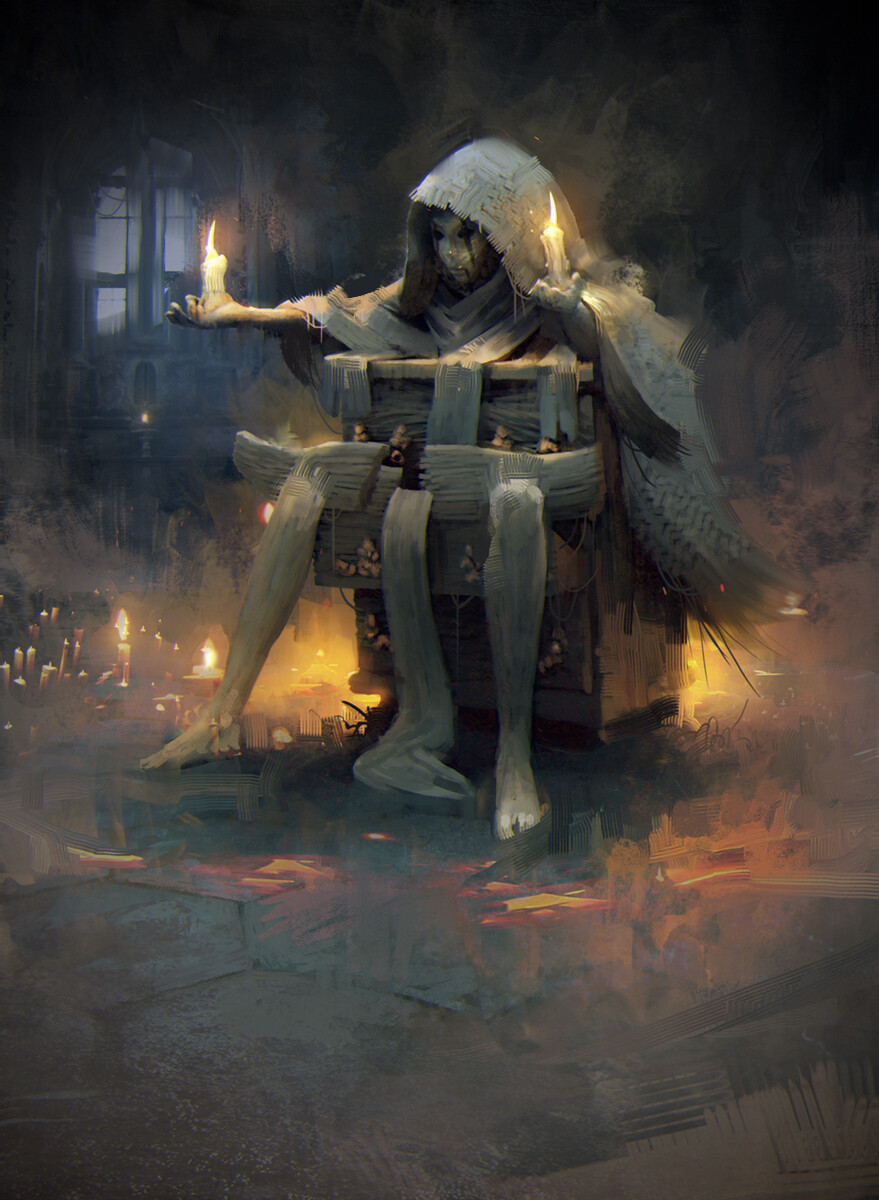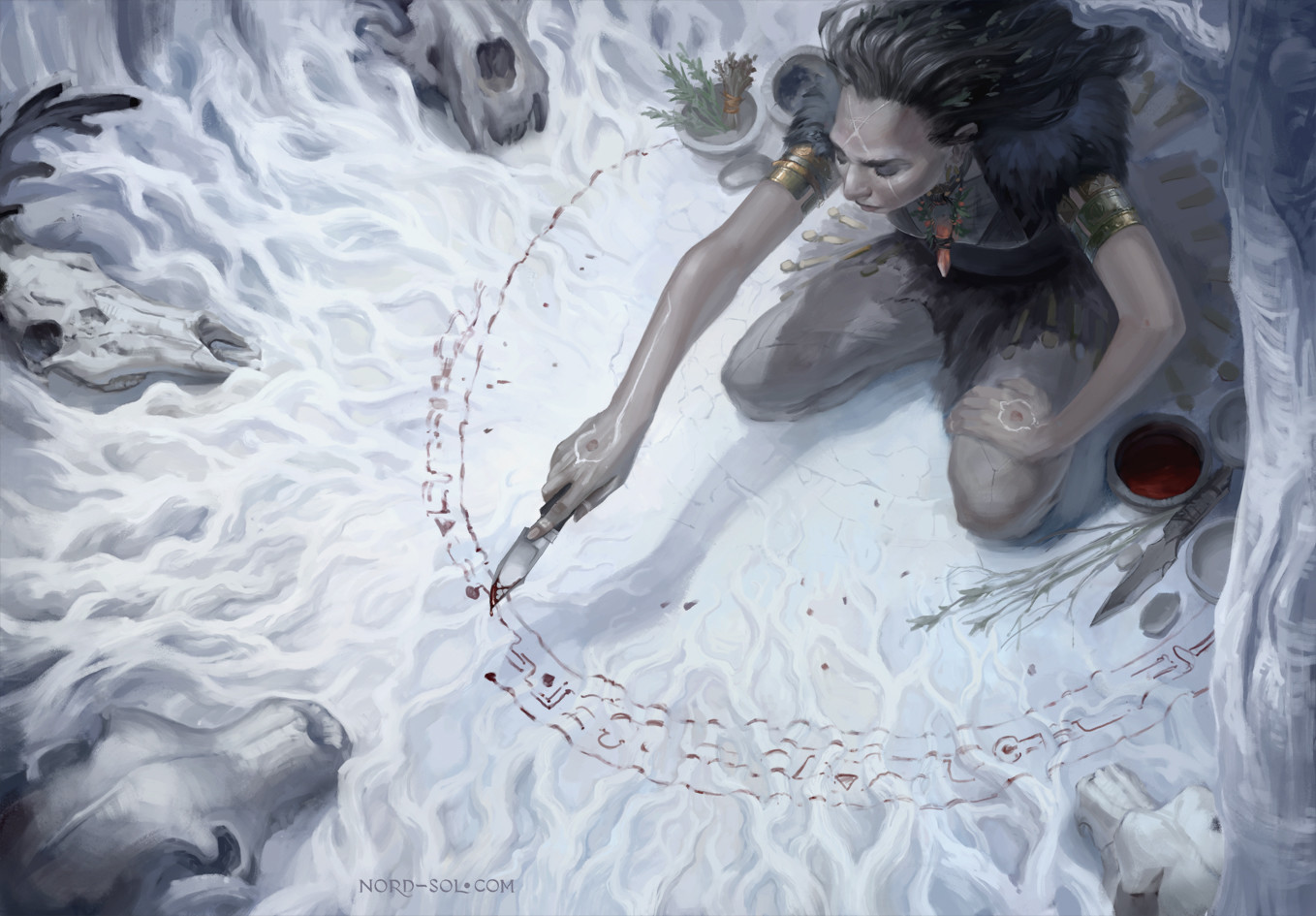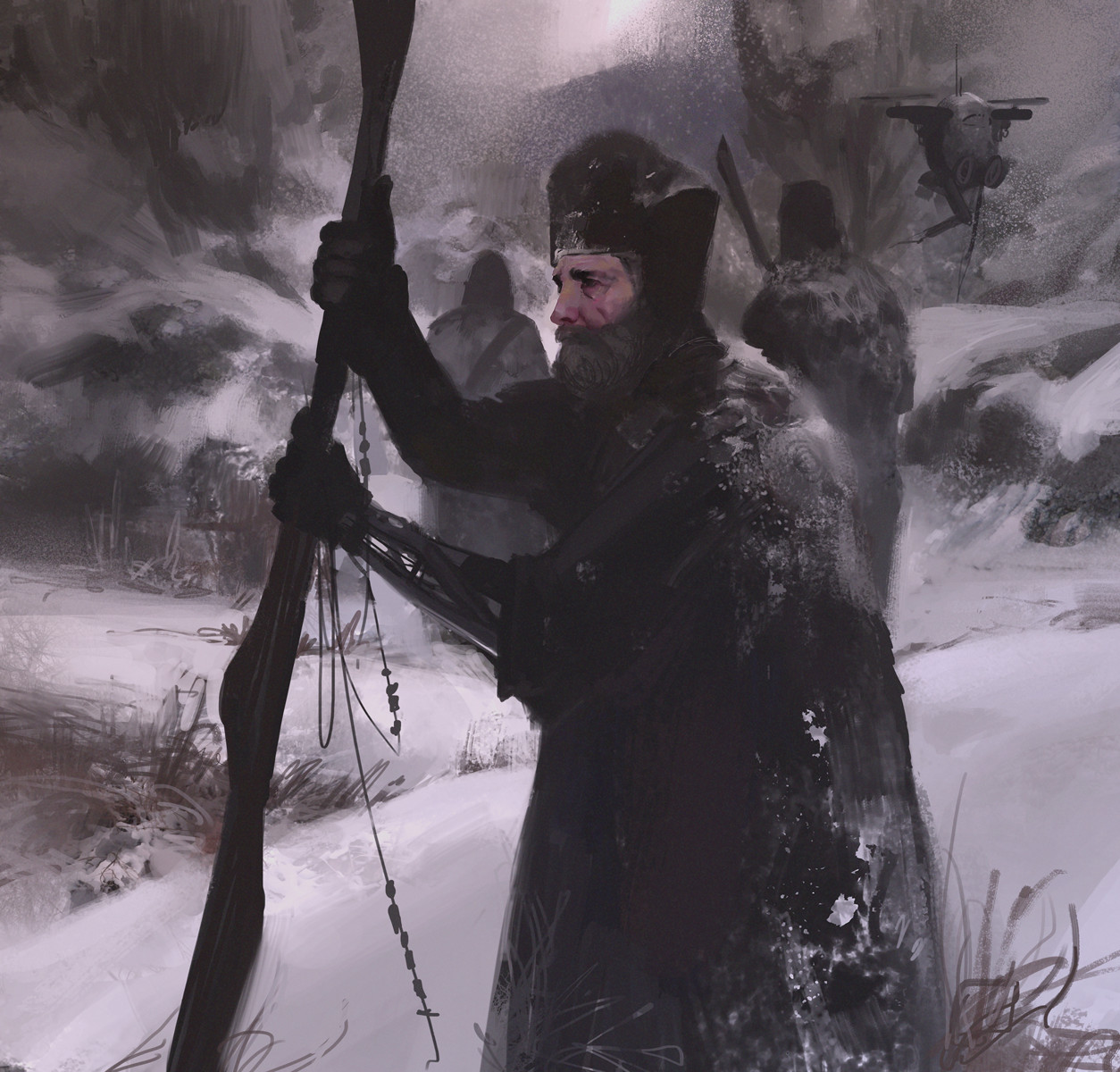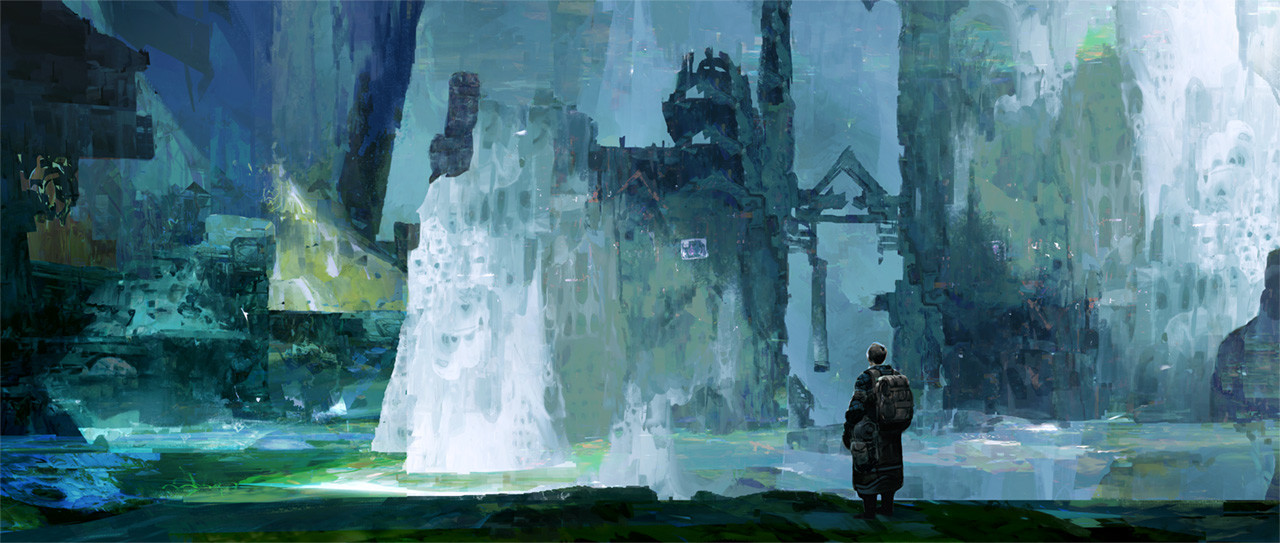I want to use this as a model to create my own version of D&D (as everyone else has) using some of my work on Rising Legends while also moving in a completely new direction. I also want to draw on my old Saga Style stuff too. The main thing I want, however, is to keep 5E's sub-classes. Sub-classes are, for me, the thing that honestly keeps me playing 5E; I like ever more precise, specific character concepts - which, I know, is kind of heretical to people who usually "trim the fat" from D&D. On top of this, I want to use my own created spellbooks (which I plan to make more of soon) for this. Magic is the reason I play Fantasy; watching how the Weird changes the Normal is the kind of art I'm usually interested in making.
So with those steps outlined, let's look at what I am thinking so far.
 |
| Piotr Foksowicz |
5E Sublme is the working name I'm going for. The sublime, in a literary sense, is used to described scenes, characters, events, or stories that are greater than human in a way difficult to understand or comprehend. One never fully notices when they slip into the sublime, but they are always aware that something is sublime around them. Because something is sublime, they cannot escape or look away from it. Instead, they must work with it, enter it, or be destroyed by it.
The sublime is the core of what I like in RPGs. It doesn't have to be magical, it can just be intense humanity, crazy sci-fi concepts, etc. I'd like to think that something like Dungeon Crawl Classics is a pretty sublime game, or Troika!.
I've mentioned that I'm using 5E HARDCORE MODE as my model for building this, so there's a few things I want to lift from it to keep. Those are:
- How hit die + rests work.
- How monsters + CR now works.
- How initiative + skill/off skill works.
- Respawning methods.
- Level 10 cap.
- Zones/Movement.
With that in mind, the following are concepts I plan to change/use for 5E Sublime.
- Class features almost exclusively being sub-class features.
- Different way of gaining experience.
- Different way of casting spells.
- Adding in an Explorer procedure.
- Making use of 5E's Exhaustion system as a consequence system.
- Additional survival tool (indomitable).
Everything not covered by one of these two sets of changes is in the D&D Basic Rules (if you need it).
 |
| Saeed Farhangian |
Classes are defined in 5E Sublime as methods in which you (the players) enter the world of the sublime. These are the things that make you something greater than human.
Each class comes as a duo-package. There is a version of it more focused on "tricks" and a version more focused on "combat." At 1st level, you gain a class feature. At every even level afterwards, you gain sub-class features. For your sub-class, find your favorite sub-class from that class in your 5E books and use it. If a sub-class grants multiple features at the same level, then you gain all of those features when you learn one of them. For example, if your Sorcerer sub-class learns two features at 6th level in core 5E, you would learn both of these at 4th level in 5E Sublime. If your sub-class wouldn't grant you 5 different levels of features in 5E Sublime, you would instead learn that classes 20th level capstone in core D&D at 10th level.
The Classes Are:
- Cleric/Paladin - Entering the sublime through faith in a religion, power, creed, or oath.
- Monk/Disciple - Entering the sublime through internal ki or psionic mutation.
- Sorcerer/Artificer - Entering the sublime through being born afflicted with magic or knowing how to forge magic into tools.
- Warlock/Hexer - Entering the sublime through strange pacts or drastic modifications of the self.
Note that all classes are mystical in some way, and that I don't add a thief class. Any of these can be thieves, and 5E Sublime is a game about exploring strange magics and how they effect people, societies, etc. As you progress, you'll get weirder and weirder, more and more sublime, until eventually you hit level 10 or otherwise die for good.
The Hexer uses Matt Mercer's Blood Hunter 2020 for its sub-class options. I changed the name to fit an aesthetic I prefer.
In the above class list, classes on the left side are considered Mystics, while those on the right side are considered Warlords. This is important to remember just for keeping up with stuff below.
Class progression is as thus:
- First class feature. Mystics start with 3 spells of a tradition. Warlords have a fighting style + 2 attacks.
- Sub-class feature(s).
- Mystics automatically learn 3 more spell of a known tradition. Warlords gain 1 Indomitable use.
- Sub-class feature(s).
- Mystics +3 spell of a tradition. Warlords +1 Indomitable use.
- Sub-class feature(s).
- M +3 spell of a tradition. W +1 Indomitable use.
- Sub-class feature(s).
- M +3 spell of a tradition. W +1 Indomitable use.
- Sub-class feature(s) OR (if not viable) class capstone feature.
A tradition is a tradition of spellcasting. This is the broad term given to spellbooks I've developed and have used so far. An example is my recent blogpost on the Plane of Lightning and the magical tradition that stems from it. Keep in note that Mystics can learn spells by finding them/being taught in addition to leveling up. Warlords can learn spells through the same means. Adventuring to learn new magic is one of the core reasons to adventure in 5E Sublime.
Indomitable is a feature taken from the core Fighter class . Once per rest, a Warlord class can dig deep into themselves to overcome a failed saving throw. I choose this as their special gain as I like the aesthetic of these kinds of characters somehow, through a method no one else can, just shaking off the effects of some supernatural hazard or other doom.
You gain a level through earning experience. Experience is earned by taking on sublime challenges. All things, from monsters to traps to riddles and puzzles, should have a CR attached to them. Using 5E HARDCORE's math, you get experience from something equal to CR x 200. All other 5E HARDCORE CR guidelines are in use, streamlining the numbers needed to overcome these challenges.
Mystics require the following experience to gain levels:
- 0
- 300
- 900
- 2300
- 6500
- 14,000
- 23,000
- 31,000
- 37,000
- 40,000
Warlords require the following experience to gain levels:
- 0
- 200
- 600
- 1800
- 4200
- 6000
- 11,000
- 18,000
- 24,000
- 30,000
As it takes longer to level, your Proficiency bonus increases a bit faster. Starting at +2, it increases by 1 every three levels after, to a maximum of +5.
 |
| Irina Nordsol Kuzmina |
Spells and magic items and weird shit are the core of the game. Finding this stuff is the real reward. Experience is for you to get more tools to find cooler stuff so that you can dig deeper into the sublime on your adventures.
All classes have spellcasting as an inherent feature. Manifesting a spell is rough on the body; thus, you can only cast as many spells as you have HD. Once you run out, you must finish a long rest to regain all uses. If you have a feature that uses spellslots, it instead uses one of your spell castings for the day. If you are out of spell slots, you can risk your life to cast a spell instead. Roll 2d6 + your Proficiency bonus. On a 10 or higher, you cast a spell. On a 9 or lower, you cast the spell but lose hit points = to the amount under 10. So, if you cast a spell with no castings left and roll a 5, you lose 5 hit points. The spell will cast, even if this kills you.
You can learn additional spells on an adventure through a number of ways. If you find a master, you can buy an education from them (either through favors, wealth, or magical items). If you find scrolls, you can decipher them and try to teach yourself (though if you ever use the scroll, note that it is destroyed in the casting!). Every tradition has its own guidelines for how long it takes to learn a spell through it. Once that time has passed, you have to make a check. The DC for the check is 15 + the Spell's level. The roll made is d20 + Proficiency bonus + Int or Wis or Cha modifier (determined by class). If you fail, something about you changes internally; you cannot attempt to relearn the spell for a year and a day after failing.
 |
| Tomas Osang Muir |
Exhaustion is key! Exhaustion is my favorite mechanic in 5E and it has gone underutilized for too long!
Primarily, exhaustion is inflicted in 5E Sublime through new ways to add challenges to exploration.
- When a saving throw is failed against a trap or hazard, a player can elect to take 1 level of exhaustion instead of suffering damage.
- When a player fails their check to cast a spell without having any spellcastings left, they can elect to take 1 level of exhaustion instead of suffering damage.
- When a player suffers more than 10 damage from a single attack or effect, they can elect to take 1 level of exhaustion and halve the incoming damage.
- Some traps or hazards or other effects may simply just inflict exhaustion instead of other banes.
Exhaustion is removed in the standard ways; however, if a player rests for 20-24 hours at once (essentially a full day), they can remove all levels of exhaustion. This should be difficult to achieve! A player having a full day of rest is subject to the danger of being discovered, of dungeons or areas resetting, or of losing an opportunity to gain something important!
 |
| Thomas Scholes |
- Decide if you are either Crawling (IE in a dungeon or similar area) or Ranging (IE in open wilderness or a ship).
- If Crawling, a round is 10 minutes. If Ranging, a round is 1 day.
- When a round starts, explain everything they see. If a player's passive Perception beats the DC for finding something, they should automatically find that thing.
- On every player's turn, ask them what they are doing. Do not resolve these actions yet. This should be stuff that achieves a single task, like finding clean water, hunting, preparing food, searching for possible places to camp, investigating, etc.
- At the end of the round, have all players roll any ability checks needed and introduce any hazards, complications, or dangers. Everything happens at once for tension and adding weight to decisions.
- If a hazard/complication/danger has appeared, resolve it before beginning the next Crawling/Ranging round.
- When a new round starts, ask the players where they've moved (to a new hex or point, to a new dungeon room, a new zone, etc) and start the process over.
Keeping track of time lets me keep track of all the basic stuff like dehydration etc. I can apply exhaustion for penalties more easily, add more nuance to traveling, and so on. This is basic stuff, just stripped down in a way to use with 5E.
Encumbrance is mentioned too, but not in 5E's atomic detail. Your Constitution ability score + your Intelligence modifier = how many slots you have. This is because your body's constitution determines how much you can load it with, and your intelligence is how smartly you pack your stuff. You need a bag to carry; if you don't have a bag, chest, etc, you can only carry stuff in your hands or wear it.
- Armors and large things use 5 slots if not worn.
- Weapons + shields use 2 slots if not held.
- Meals, gallons of liquid, coin purses, and all other things are 1 slot (within reason).
 |
| Anato Finnstark |
Next blogpost in this series, I'll go over the 8 classes, their 1st level abilities, their saving throws, and talk about how I wanna do races. After that, its a matter of playtesting this stuff and making more spellbooks and challenges. I'm not sure if I'll ever publish this ruleset, but at the very least I'll condense it one day for ease of giving to my players.
No comments:
Post a Comment